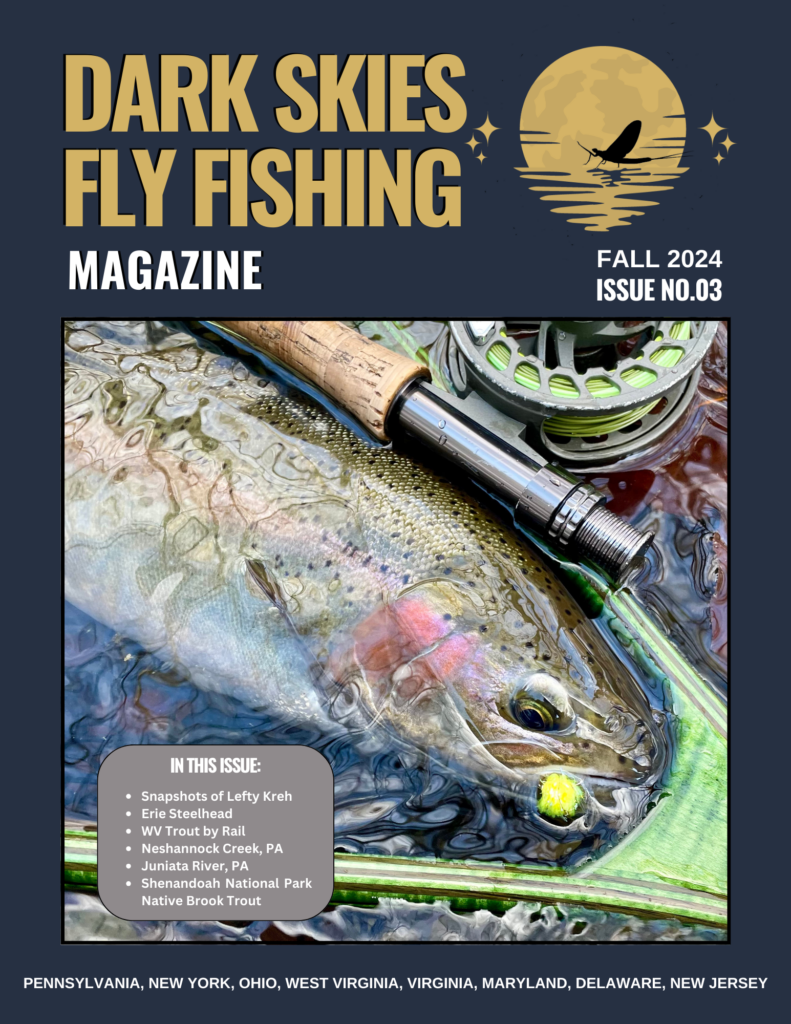Ohio Steelhead: Fat Fish in Skinny Water

When I was a kid living in Western New York, I remember a news report about the Cuyahoga River in Ohio, a tributary of Lake Erie, catching on fire. Even to an elementary schooler, the idea of water being aflame was pretty fantastical.
Back then, the vast Lake Erie was biologically dead.
Thankfully, the Cuyahoga fire spurred local and national policies such as the 1972 Clean Water Act that cleaned up the water from the heavy industry that ringed Lake Erie, stretching from Cleveland to Buffalo.
Today, Erie is the most biologically-productive of the five Great Lakes.
That means fishing for walleye, lake trout, and steelhead, a migratory cousin of the rainbow trout originally from the Pacific. Out West, anadromous steelies live in the Pacific Ocean’s saltwater and make runs into freshwater to spawn. In Lake Erie, the 4th largest Great Lake and the 13th largest freshwater lake in the world, lake-run steelhead do similarly, except they live their entire lives in freshwater. Living in a Great Lake, with lots of forage, is very similar to living in the ocean.
These fish are muscle-bound and feisty.
I’ve fished for steelies in Western New York (South of Buffalo), a number of times, but wanted to give some other parts of Steelhead Alley, which runs from Ohio through Pennsylvania to New York, a try.
I hooked up (pun intended) with a bunch of Falmouth Flats Fly Fishers club members from the Northern Virginia area (where I live) to do a DIY steelhead trip to Ohio for this year’s spring run. These chromeheads (as steelhead fishers are sometimes known) had done this before and knew what they were doing.
In mid-March, we headed for the Cleveland area and settled in for a few days at Geneva-on-the-Lake, which is northeast of the “Forest City.” The plan was to fish the Grand River tributaries for a couple days.
Fortunately, the weather was mild–remember it’s still technically winter in the Midwest and along the Great Lakes; some rain in the days before we arrived would raise water levels and likely encourage some steel to move upstream.
Let’s be clear: This isn’t western U.S. steelheading on big, wide rivers with 12-foot Spey rods. The Ohio Great Lake tributaries can be quite small and the fishing can be tight, which, fortunately, isn’t bad news. Indeed, this is good!

Ohio Steelhead Opportunities
The Ohio steelhead are often within reach of the shore or easy wading; this situation means catch rates are reportedly much higher for Great Lake steelhead than for big-river chrome out West, where swinging a fly to cover large stretches of water in search of fish is the norm.
The Great Lakes are, well, in a word, great for a steelheading newbie.
I used an 8-weight, single-handed rod with a floating line and 0x-2x leader to sight-fish for steelhead moving up stream. For flies, swinging or high-sticking eggs, stoneflies, and baitfish patterns all seemed to work. A sinking tip or split shot is useful to have in your vest for deeper water.
I have to admit that–with fish swimming just a few feet away–sight-fishing to a big-shouldered rainbow trout, which has no interest in your offering, can be frustrating. For the most part, since they’re spawning, a steelhead will strike only out of instinct or annoyance.
But they will eat–and then it’s a county fair rodeo!
If there’s enough water, be prepared for a good, hard run upstream or downstream; they may also break you off on a rock or bury themselves into a log jam. Hooks have been bent or broken, and landing one could take some 15 minutes–or more.
These Ohio steelhead average 25-inches and seven pounds, according to Ohio Department of Natural Resources (DNR).
Beware: Trying to net a steelie yourself is a fool’s errand. Team-net, instead, if possible. Like they say: “Teamwork makes the dream work.” And don’t bring a brook trout net to a steelhead fight. They won’t fit, and you can kiss your hero shot for the folks back home goodbye.
It’s important to note that the Lake’s Steelhead Alley isn’t all the same. Each Steelhead Alley state has different stocking programs, meaning that runs will vary. The stocked, yearling smolts imprint on their natal streams, and then outmigrate to the bigger waters in the Lake.
Ohio stocks some 450,000 smolts annually. After two to three years of packing on the pounds in the Lake on shad, alewife, smelts, shiners, and other bait fish, they return to their home streams.
The Ohio waters have two annual runs, one in the spring, starting in late September and one in the fall, beginning in mid-February, depending on prevailing weather and water flows. For more specific info, see Ohio DNR’s steelhead landing page.

Fishing Access
Another pleasant surprise was how accessible the steelhead tributaries were in Lake County, where we fished; a number of county parks are located along good fishing spots. Lake County Metroparks has a great page where you can find maps and other information about local angling.
And don’t forget your Ohio fishing license–not that you would–but we saw plenty of friendly Ohio wildlife officers checking licenses (especially if you had an out-of-state plate). Nothing wrong with that–it’s a part of their job, among other important and necessary duties.
In fact, the Ohio wildlife officers were a great source of on-the-spot local fishing information–and, in my opinion, were over-the-top helpful in assisting us hook up with these amazing fish.
The internationally-acclaimed Lake Erie steel industry that helped build this great country isn’t what it once was in the 1970s when I was a kid, but the steelhead fishing in Lake Erie–that didn’t exist back then–is, without question, world-class.
Did You Enjoy This Article?
Stay up to date with the Dark Skies Fly Fishing monthly newsletter for free and receive the latest posts in fly fishing news, tricks, tips, and techniques, stream reports, as well as updates on new flies added to the Online Store and exclusive discounts!
Sign Up Now

Pete – are there ANY bad days on one of your excursions? Every picture in every article: a triumphant grin holding a gorgeous catch! How about one sullen, rainy, empty-net-in-hand, and a droopy waterlogged hat? :-). Wonderful story, beautifully written, as always. Congrats! Dakota
Dakota: I’m just trying to bring peace and love to the world one hero grip-n-grin at a time… 🙂